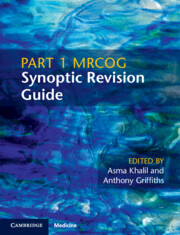Book contents
- Part 1 MRCOG Synoptic Revision Guide
- Part 1 MRCOG Synoptic Revision Guide
- Copyright page
- Contents
- Contributors
- Chapter 1 Physiology of Pregnancy and Labour
- Chapter 2 Fetal Physiology
- Chapter 3 Acid-Base Balance
- Chapter 4 Female Reproductive Physiology
- Chapter 5 Male Reproductive Physiology
- Chapter 6 The Pituitary, Adrenal, Thyroid and Pancreas
- Chapter 7 Congenital Infections
- Chapter 8 Data Interpretation in Obstetrics
- Chapter 9 Clinical Management in Obstetrics
- Chapter 10 Concise Anatomy of the Urinary, Intestinal and Reproductive Tracts within the Pelvic Cavity
- Chapter 11 Concise Anatomy of the Pelvic Floor and Perineum
- Chapter 12 Concise Anatomy of the Pelvic Girdle
- Chapter 13 Concise Anatomy of the Abdominal Walls
- Chapter 14 Early Embryonic Development
- Chapter 15 Development of the Gastrointestinal and Urogenital Tracts
- Chapter 16 Problems in Early Pregnancy
- Chapter 17 Human Immunodeficiency Virus and Other Sexually Transmitted Infections
- Chapter 18 Pharmacokinetics, Pharmacodynamics and Teratogenesis
- Chapter 19 Non-hormonal Therapy in Obstetrics and Gynaecology
- Chapter 20 Drugs in Gynaecology and Contraception
- Chapter 21 Surgical Site Surveillance
- Chapter 22 Data Interpretation in Gynaecology
- Chapter 23 Clinical Management in Gynaecology
- Chapter 24 Carbohydrate Metabolism
- Chapter 25 Fat Metabolism
- Chapter 26 Steroid Hormones and Prostaglandins
- Chapter 27 Calcium Homeostasis and Bone Health
- Chapter 28 Cell Structure and Function
- Chapter 29 Cellular Responses in Disease
- Chapter 30 Pathology of Non-neoplastic and Neoplastic Gynaecological Diseases
- Chapter 31 Implantation and Placental Structure and Function
- Chapter 32 Basic and Reproductive Immunology
- Chapter 33 Molecular Biology
- Chapter 34 Single-Gene and Chromosome Abnormalities
- Chapter 35 Genetic Screening and Diagnosis
- Chapter 36 Biophysics
- Chapter 37 Statistics
- Chapter 38 Clinical Trials, Audit and Meta-analysis
- Appendix: Answers to SBA Questions
- Index
- References
Chapter 24 - Carbohydrate Metabolism
Published online by Cambridge University Press: 27 July 2023
- Part 1 MRCOG Synoptic Revision Guide
- Part 1 MRCOG Synoptic Revision Guide
- Copyright page
- Contents
- Contributors
- Chapter 1 Physiology of Pregnancy and Labour
- Chapter 2 Fetal Physiology
- Chapter 3 Acid-Base Balance
- Chapter 4 Female Reproductive Physiology
- Chapter 5 Male Reproductive Physiology
- Chapter 6 The Pituitary, Adrenal, Thyroid and Pancreas
- Chapter 7 Congenital Infections
- Chapter 8 Data Interpretation in Obstetrics
- Chapter 9 Clinical Management in Obstetrics
- Chapter 10 Concise Anatomy of the Urinary, Intestinal and Reproductive Tracts within the Pelvic Cavity
- Chapter 11 Concise Anatomy of the Pelvic Floor and Perineum
- Chapter 12 Concise Anatomy of the Pelvic Girdle
- Chapter 13 Concise Anatomy of the Abdominal Walls
- Chapter 14 Early Embryonic Development
- Chapter 15 Development of the Gastrointestinal and Urogenital Tracts
- Chapter 16 Problems in Early Pregnancy
- Chapter 17 Human Immunodeficiency Virus and Other Sexually Transmitted Infections
- Chapter 18 Pharmacokinetics, Pharmacodynamics and Teratogenesis
- Chapter 19 Non-hormonal Therapy in Obstetrics and Gynaecology
- Chapter 20 Drugs in Gynaecology and Contraception
- Chapter 21 Surgical Site Surveillance
- Chapter 22 Data Interpretation in Gynaecology
- Chapter 23 Clinical Management in Gynaecology
- Chapter 24 Carbohydrate Metabolism
- Chapter 25 Fat Metabolism
- Chapter 26 Steroid Hormones and Prostaglandins
- Chapter 27 Calcium Homeostasis and Bone Health
- Chapter 28 Cell Structure and Function
- Chapter 29 Cellular Responses in Disease
- Chapter 30 Pathology of Non-neoplastic and Neoplastic Gynaecological Diseases
- Chapter 31 Implantation and Placental Structure and Function
- Chapter 32 Basic and Reproductive Immunology
- Chapter 33 Molecular Biology
- Chapter 34 Single-Gene and Chromosome Abnormalities
- Chapter 35 Genetic Screening and Diagnosis
- Chapter 36 Biophysics
- Chapter 37 Statistics
- Chapter 38 Clinical Trials, Audit and Meta-analysis
- Appendix: Answers to SBA Questions
- Index
- References
Summary
Carbohydrates present the most accessible energy source for many tissues. Glucose is the only fuel that can be respired anaerobically, for example by the Type 2 skeletal muscle fibre during intensive exercise or by the erythrocyte which has no mitochondria. It is also the preferred fuel for the central nervous system (CNS). The brain has a sustained high energy requirement to allow continuous ion pumping and maintenance of membrane potentials, and accounts for approximately 20% of resting energy expenditure in the fat-free mass of the adult. In the fed state, the brain consumes only glucose, oxidising it to supply 100% of its energy requirement, accounting for about 120 g glucose per day in the adult. In the starving state, the brain may reduce its glucose requirement by up to 75% by consumption of ketone bodies but the remaining 25% of its energy must always come from glucose. Lipoproteins do not cross the blood-brain barrier, depriving the brain of fat as an oxidative fuel. The dependence of the CNS on glucose justifies the complexities of glucose homeostatic mechanisms designed to maintain availability of this substrate through the bloodstream and explains the potentially coma-inducing consequences of poorly controlled diabetes or excessive alcohol consumption.
- Type
- Chapter
- Information
- Part 1 MRCOG Synoptic Revision Guide , pp. 238 - 247Publisher: Cambridge University PressPrint publication year: 2023



